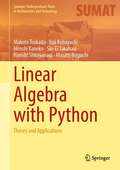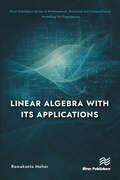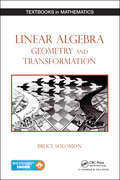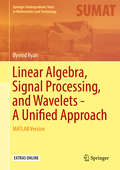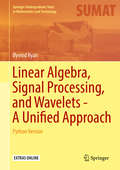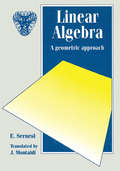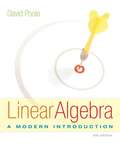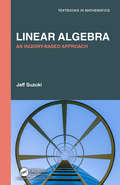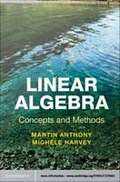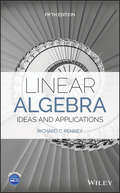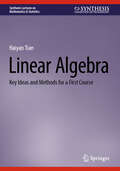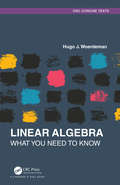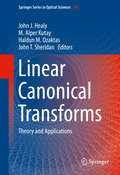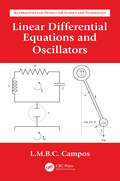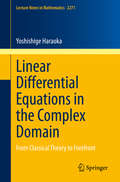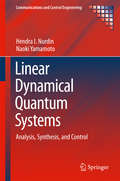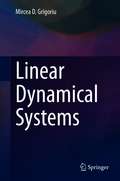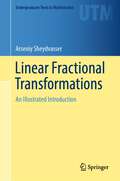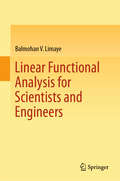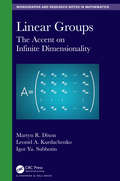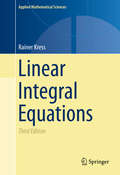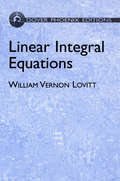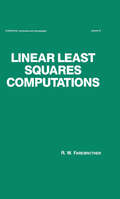- Table View
- List View
Linear Algebra with Python: Theory and Applications (Springer Undergraduate Texts in Mathematics and Technology)
by Makoto Tsukada Yuji Kobayashi Hiroshi Kaneko Sin-Ei Takahasi Kiyoshi Shirayanagi Masato NoguchiThis textbook is for those who want to learn linear algebra from the basics. After a brief mathematical introduction, it provides the standard curriculum of linear algebra based on an abstract linear space. It covers, among other aspects: linear mappings and their matrix representations, basis, and dimension; matrix invariants, inner products, and norms; eigenvalues and eigenvectors; and Jordan normal forms. Detailed and self-contained proofs as well as descriptions are given for all theorems, formulas, and algorithms. A unified overview of linear structures is presented by developing linear algebra from the perspective of functional analysis. Advanced topics such as function space are taken up, along with Fourier analysis, the Perron–Frobenius theorem, linear differential equations, the state transition matrix and the generalized inverse matrix, singular value decomposition, tensor products, and linear regression models. These all provide a bridge to more specialized theories based on linear algebra in mathematics, physics, engineering, economics, and social sciences. Python is used throughout the book to explain linear algebra. Learning with Python interactively, readers will naturally become accustomed to Python coding. By using Python’s libraries NumPy, Matplotlib, VPython, and SymPy, readers can easily perform large-scale matrix calculations, visualization of calculation results, and symbolic computations. All the codes in this book can be executed on both Windows and macOS and also on Raspberry Pi.
Linear Algebra with its Applications (River Publishers Series in Mathematical, Statistical and Computational Modelling for Engineering)
by Ramakant MeherThis book contains a detailed discussion of the matrix operation, its properties, and its applications in finding the solution of linear equations and determinants. Linear algebra is a subject that has found the broadest range of applications in all branches of mathematics, physical and social sciences, and engineering. It has a more significant application in information sciences and control theory.A definition of linear algebra is that it is a part of algebra which is concerned with equations of the first degree. Thus, at the fundamental level, it involves the discussion of matrices and determinants, and the solutions of systems of linear equations, which have a wide application in further discussion of this subject.Technical topics discussed in the book include: Matrices Vector spaces Eigenvalue and eigenvectors Linear transformation Inner product spaces Diagonalizations Applications to conics and quadrics Canonical forms Least squares problems
Linear Algebra, Geometry and Transformation (Textbooks in Mathematics)
by Bruce SolomonThe Essentials of a First Linear Algebra Course and MoreLinear Algebra, Geometry and Transformation provides students with a solid geometric grasp of linear transformations. It stresses the linear case of the inverse function and rank theorems and gives a careful geometric treatment of the spectral theorem.An Engaging Treatment of the Interplay amo
Linear Algebra, Signal Processing, and Wavelets - A Unified Approach: MATLAB Version (Springer Undergraduate Texts in Mathematics and Technology)
by Øyvind RyanThis book offers a user friendly, hands-on, and systematic introduction to applied and computational harmonic analysis: to Fourier analysis, signal processing and wavelets; and to their interplay and applications. The approach is novel, and the book can be used in undergraduate courses, for example, following a first course in linear algebra, but is also suitable for use in graduate level courses. The book will benefit anyone with a basic background in linear algebra. It defines fundamental concepts in signal processing and wavelet theory, assuming only a familiarity with elementary linear algebra. No background in signal processing is needed. Additionally, the book demonstrates in detail why linear algebra is often the best way to go. Those with only a signal processing background are also introduced to the world of linear algebra, although a full course is recommended. The book comes in two versions: one based on MATLAB, and one on Python, demonstrating the feasibility and applications of both approaches. Most of the MATLAB code is available interactively. The applications mainly involve sound and images. The book also includes a rich set of exercises, many of which are of a computational nature.
Linear Algebra, Signal Processing, and Wavelets - A Unified Approach: Python Version (Springer Undergraduate Texts in Mathematics and Technology)
by Øyvind RyanThis book offers a user friendly, hands-on, and systematic introduction to applied and computational harmonic analysis: to Fourier analysis, signal processing and wavelets; and to their interplay and applications. The approach is novel, and the book can be used in undergraduate courses, for example, following a first course in linear algebra, but is also suitable for use in graduate level courses. The book will benefit anyone with a basic background in linear algebra. It defines fundamental concepts in signal processing and wavelet theory, assuming only a familiarity with elementary linear algebra. No background in signal processing is needed. Additionally, the book demonstrates in detail why linear algebra is often the best way to go. Those with only a signal processing background are also introduced to the world of linear algebra, although a full course is recommended.The book comes in two versions: one based on MATLAB, and one on Python, demonstrating the feasibility and applications of both approaches. Most of the code is available interactively. The applications mainly involve sound and images. The book also includes a rich set of exercises, many of which are of a computational nature.
Linear Algebra: A First Course with Applications (Textbooks in Mathematics)
by Larry E. KnopLinear Algebra: A First Course with Applications explores the fundamental ideas of linear algebra, including vector spaces, subspaces, basis, span, linear independence, linear transformation, eigenvalues, and eigenvectors, as well as a variety of applications, from inventories to graphics to Google's PageRank. Unlike other texts on the subject, thi
Linear Algebra: A Geometric Approach (Chapman Hall/crc Mathematics Ser. #7)
by E. SernesiThis is an undergraduate textbook suitable for linear algebra courses. This is the only textbook that develops the linear algebra hand-in-hand with the geometry of linear (or affine) spaces in such a way that the understanding of each reinforces the other. The text is divided into two parts: Part I is on linear algebra and affine geometry, finis
Linear Algebra: A Modern Introduction
by David PooleThis fourth edition emphasizes a vectors approach and better prepares students to make the transition from computational to theoretical mathematics. Balancing theory and applications, the book is written in a conversational style and combines a traditional presentation with a focus on student-centered learning. Theoretical, computational, and applied topics are presented in a flexible yet integrated way. Stressing geometric understanding before computational techniques, vectors and vector geometry are introduced early to help students visualize concepts and develop mathematical maturity for abstract thinking. Additionally, the book includes ample applications drawn from a variety of disciplines, which reinforce the fact that linear algebra is a valuable tool for modeling real-life problems.
Linear Algebra: An Inquiry-Based Approach (Textbooks in Mathematics)
by Jeff SuzukiLinear Algebra: An Inquiry-based Approach is written to give instructors a tool to teach students to develop a mathematical concept from first principles. The Inquiry-based Approach is central to this development. The text is organized around and offers the standard topics expected in a first undergraduate course in linear algebra. In our approach, students begin with a problem and develop the mathematics necessary to describe, solve, and generalize it. Thus students learn a vital skill for the 21st century: the ability to create a solution to a problem. This text is offered to foster an environment that supports the creative process. The twin goals of this textbook are: Providing opportunities to be creative, Teaching "ways of thinking" that will make it easier for to be creative. To motivate the development of the concepts and techniques of linear algebra, we include more than two hundred Activities on a wide range of problems, from purely mathematical questions, through applications in biology, computer science, cryptography, and more. Table of Contents Introduction and Features For the Student . . . and Teacher Prerequisites Suggested Sequences 1. Tuples and Vectors 2. Systems of Linear Equations 3. Transformations 4. Matrix Algebra 5. Vector Spaces 6. Determinants 7. Eigenvalues and Eigenvectors 8. Decomposition 9. Extras Bibliography Index Bibliography Jeff Suzuki is Associate Professor of Mathematics at Brooklyn College and holds a Ph.D. from Boston University. His research interests include mathematics education, history of mathematics, and the application of mathematics to society and technology. He is a two-time winner of the prestigious Carl B. Allendoerfer Award for expository writing. His publications have appeared in The College Mathematics Journals; Mathematics Magazine; Mathematics Teacher; and the American Mathematical Society's blog on teaching and learning mathematics. His YouTube channel (http://youtube.com/jeffsuzuki1) includes videos on mathematical subjects ranging from elementary arithmetic to linear algebra, cryptography, and differential equations.
Linear Algebra: Concepts and Methods
by Martin Anthony Michele HarveyAny student of linear algebra will welcome this textbook, which provides a thorough treatment of this key topic. Blending practice and theory, the book enables the reader to learn and comprehend the standard methods, with an emphasis on understanding how they actually work. At every stage, the authors are careful to ensure that the discussion is no more complicated or abstract than it needs to be, and focuses on the fundamental topics. The book is ideal as a course text or for self-study. Instructors can draw on the many examples and exercises to supplement their own assignments. End-of-chapter sections summarise the material to help students consolidate their learning as they progress through the book.
Linear Algebra: Ideas and Applications
by Richard C. PenneyPraise for the Third Edition "This volume is ground-breaking in terms of mathematical texts in that it does not teach from a detached perspective, but instead, looks to show students that competent mathematicians bring an intuitive understanding to the subject rather than just a master of applications." - Electric Review Learn foundational and advanced topics in linear algebra with this concise and approachable resource A comprehensive introduction, Linear Algebra: Ideas and Applications, Fifth Edition provides a discussion of the theory and applications of linear algebra that blends abstract and computational concepts. With a focus on the development of mathematical intuition, the book emphasizes the need to understand both the applications of a particular technique and the mathematical ideas underlying the technique. The book introduces each new concept in the context of explicit numerical examples, which allows the abstract concepts to grow organically out of the necessity to solve specific problems. The intuitive discussions are consistently followed by rigorous statements of results and proofs. Linear Algebra: Ideas and Applications, Fifth Edition also features: A new application section on section on Google’s Page Rank Algorithm. A new application section on pricing long term health insurance at a Continuing Care Retirement Community (CCRC). Many other illuminating applications of linear algebra with self-study questions for additional study. End-of-chapter summaries and sections with true-false questions to aid readers with further comprehension of the presented material Numerous computer exercises throughout using MATLAB® code Linear Algebra: Ideas and Applications, Fifth Edition is an excellent undergraduate-level textbook for one or two semester undergraduate courses in mathematics, science, computer science, and engineering. With an emphasis on intuition development, the book is also an ideal self-study reference.
Linear Algebra: Key Ideas and Methods for a First Course (Synthesis Lectures on Mathematics & Statistics)
by Haiyan TianThis book presents algebra in a concise and clear way, allowing beginner students to quickly attain the required proficiency. As to opposed to existing books on the subject that cover too many topics, some of which are too complex and intimidating for a first course in linear algebra, this book only presents the essential topics in a more user-friendly manner. The author includes an optimized order of topics that are adapted to the learning patterns of students. In addition, carefully designed examples are presented to enhance reader confidence to master the material and to avoid frequently observed frustration. This textbook is ideal for a one semester course on basic linear algebra for college students majoring in mathematics, engineering, and other sciences.
Linear Algebra: What you Need to Know (Textbooks in Mathematics)
by Hugo J. WoerdemanThis book is intended for a first linear algebra course. The text includes all essential topics in a concise manner and can therefore be fully covered in a one term course. After this course, the student is fully equipped to specialize further in their direction(s) of choice (advanced pure linear algebra, numerical linear algebra, optimization, multivariate statistics, or one of the many other areas of linear algebra applications). Linear Algebra is an exciting area of mathematics that is gaining more and more importance as the world is becoming increasingly digital. It has the following very appealing features: It is a solid axiomatic based mathematical theory that is accessible to a large variety of students. It has a multitude of applications from many different fields, ranging from traditional science and engineering applications to more ‘daily life’ applications (internet searches, guessing consumer preferences, etc.). It easily allows for numerical experimentation through the use of a variety of readily available software (both commercial and open source). This book incorporates all these aspects throughout the whole text with the intended effect that each student can find their own niche in the field. Several suggestions of different software are made. While MATLAB is certainly still a favorite choice, open source programs such as Sage (especially among algebraists) and the Python libraries are increasingly popular. This text guides the student through different programs by providing specific commands.
Linear Canonical Transforms
by John J. Healy M. Alper Kutay Haldun M. Ozaktas John T. SheridanThis book provides a clear and accessible introduction to the essential mathematical foundations of linear canonical transforms from a signals and systems perspective. Substantial attention is devoted to how these transforms relate to optical systems and wave propagation. There is extensive coverage of sampling theory and fast algorithms for numerically approximating the family of transforms. Chapters on topics ranging from digital holography to speckle metrology provide a window on the wide range of applications. This volume will serve as a reference for researchers in the fields of image and signal processing, wave propagation, optical information processing and holography, optical system design and modeling, and quantum optics. It will be of use to graduate students in physics and engineering, as well as for scientists in other areas seeking to learn more about this important yet relatively unfamiliar class of integral transformations.
Linear Differential Equations and Oscillators (Mathematics and Physics for Science and Technology)
by Luis Manuel Braga da Costa CamposLinear Differential Equations and Oscillators is the first book within Ordinary Differential Equations with Applications to Trajectories and Vibrations, Six-volume Set. As a set, they are the fourth volume in the series Mathematics and Physics Applied to Science and Technology. This first book consists of chapters 1 and 2 of the fourth volume. The first chapter covers linear differential equations of any order whose unforced solution can be obtained from the roots of a characteristic polynomial, namely those: (i) with constant coefficients; (ii) with homogeneous power coefficients with the exponent equal to the order of derivation. The method of characteristic polynomials is also applied to (iii) linear finite difference equations of any order with constant coefficients. The unforced and forced solutions of (i,ii,iii) are examples of some general properties of ordinary differential equations. The second chapter applies the theory of the first chapter to linear second-order oscillators with one degree-of-freedom, such as the mechanical mass-damper-spring-force system and the electrical self-resistor-capacitor-battery circuit. In both cases are treated free undamped, damped, and amplified oscillations; also forced oscillations including beats, resonance, discrete and continuous spectra, and impulsive inputs. Describes general properties of differential and finite difference equations, with focus on linear equations and constant and some power coefficients Presents particular and general solutions for all cases of differential and finite difference equations Provides complete solutions for many cases of forcing including resonant cases Discusses applications to linear second-order mechanical and electrical oscillators with damping Provides solutions with forcing including resonance using the characteristic polynomial, Green' s functions, trigonometrical series, Fourier integrals and Laplace transforms
Linear Differential Equations in the Complex Domain: From Classical Theory to Forefront (Lecture Notes in Mathematics #2271)
by Yoshishige HaraokaThis book provides a detailed introduction to recent developments in the theory of linear differential systems and integrable total differential systems. Starting from the basic theory of linear ordinary differential equations and integrable systems, it proceeds to describe Katz theory and its applications, extending it to the case of several variables. In addition, connection problems, deformation theory, and the theory of integral representations are comprehensively covered. Complete proofs are given, offering the reader a precise account of the classical and modern theory of linear differential equations in the complex domain, including an exposition of Pfaffian systems and their monodromy problems. The prerequisites are a course in complex analysis and the basics of differential equations, topology and differential geometry. This book will be useful for graduate students, specialists in differential equations, and for non-specialists who want to use differential equations.
Linear Dynamical Quantum Systems
by Hendra I. Nurdin Naoki YamamotoThis monograph provides an in-depth treatment of the class of linear-dynamical quantum systems. The monograph presents a detailed account of the mathematical modeling of these systems using linear algebra and quantum stochastic calculus as the main tools for a treatment that emphasizes a system-theoretic point of view and the control-theoretic formulations of quantum versions of familiar problems from the classical (non-quantum) setting, including estimation and filtering, realization theory, and feedback control. Both measurement-based feedback control (i. e. , feedback control by a classical system involving a continuous-time measurement process) and coherent feedback control (i. e. , feedback control by another quantum system without the intervention of any measurements in the feedback loop) are treated. Researchers and graduates studying systems and control theory, quantum probability and stochastics or stochastic control whether from backgrounds in mechanical or electrical engineering or applied mathematics will find this book to be a valuable treatment of the control of an important class of quantum systems. The material presented here will also interest physicists working in optics, quantum optics, quantum information theory and other quantum-physical disciplines.
Linear Dynamical Systems
by Mircea D. GrigoriuThis textbook provides a concise, clear, and rigorous presentation of the dynamics of linear systems that delivers the necessary tools for the analysis and design of mechanical/ structural systems, regardless of their complexity. The book is written for senior undergraduate and first year graduate students as well as engineers working on the design of mechanical/structural systems subjected to dynamic actions, such as wind/earthquake engineers and mechanical engineers working on wind turbines. Professor Grigoriu's lucid presentation maximizes student understanding of the formulation and the solution of linear systems subjected to dynamic actions, and provides a clear distinction between problems of practical interest and their special cases. Based on the author's lecture notes from courses taught at Cornell University, the material is class-tested over many years and ideal as a core text for a range of classes in mechanical, civil, and geotechnical engineering, as well as for self-directed learning by practitioners in the field.
Linear Fractional Transformations: An Illustrated Introduction (Undergraduate Texts in Mathematics)
by Arseniy SheydvasserThe principle aim of this unique text is to illuminate the beauty of the subject both with abstractions like proofs and mathematical text, and with visuals, such as abundant illustrations and diagrams. With few mathematical prerequisites, geometry is presented through the lens of linear fractional transformations. The exposition is motivational and the well-placed examples and exercises give students ample opportunity to pause and digest the material. The subject builds from the fundamentals of Euclidean geometry, to inversive geometry, and, finally, to hyperbolic geometry at the end. Throughout, the author aims to express the underlying philosophy behind the definitions and mathematical reasoning. This text may be used as primary for an undergraduate geometry course or a freshman seminar in geometry, or as supplemental to instructors in their undergraduate courses in complex analysis, algebra, and number theory. There are elective courses that bring together seemingly disparate topics and this text would be a welcome accompaniment.
Linear Functional Analysis for Scientists and Engineers
by Balmohan V. LimayeThis book provides a concise and meticulous introduction to functional analysis. Since the topic draws heavily on the interplay between the algebraic structure of a linear space and the distance structure of a metric space, functional analysis is increasingly gaining the attention of not only mathematicians but also scientists and engineers. The purpose of the text is to present the basic aspects of functional analysis to this varied audience, keeping in mind the considerations of applicability. A novelty of this book is the inclusion of a result by Zabreiko, which states that every countably subadditive seminorm on a Banach space is continuous. Several major theorems in functional analysis are easy consequences of this result. The entire book can be used as a textbook for an introductory course in functional analysis without having to make any specific selection from the topics presented here. Basic notions in the setting of a metric space are defined in terms of sequences. These include total boundedness, compactness, continuity and uniform continuity. Offering concise and to-the-point treatment of each topic in the framework of a normed space and of an inner product space, the book represents a valuable resource for advanced undergraduate students in mathematics, and will also appeal to graduate students and faculty in the natural sciences and engineering. The book is accessible to anyone who is familiar with linear algebra and real analysis.
Linear Functional Analysis for Scientists and Engineers
by Balmohan V. LimayeThis book provides a concise and meticulous introduction to functional analysis. Since the topic draws heavily on the interplay between the algebraic structure of a linear space and the distance structure of a metric space, functional analysis is increasingly gaining the attention of not only mathematicians but also scientists and engineers. The purpose of the text is to present the basic aspects of functional analysis to this varied audience, keeping in mind the considerations of applicability. A novelty of this book is the inclusion of a result by Zabreiko, which states that every countably subadditive seminorm on a Banach space is continuous. Several major theorems in functional analysis are easy consequences of this result.The entire book can be used as a textbook for an introductory course in functional analysis without having to make any specific selection from the topics presented here. Basic notions in the setting of a metric space are defined in terms of sequences. These include total boundedness, compactness, continuity and uniform continuity. Offering concise and to-the-point treatment of each topic in the framework of a normed space and of an inner product space, the book represents a valuable resource for advanced undergraduate students in mathematics, and will also appeal to graduate students and faculty in the natural sciences and engineering. The book is accessible to anyone who is familiar with linear algebra and real analysis.
Linear Groups: The Accent on Infinite Dimensionality (Chapman & Hall/CRC Monographs and Research Notes in Mathematics)
by Leonid A. Kurdachenko Martyn R. Dixon Igor Ya. SubbotinLinear Groups: The Accent on Infinite Dimensionality explores some of the main results and ideas in the study of infinite-dimensional linear groups. The theory of finite dimensional linear groups is one of the best developed algebraic theories. The array of articles devoted to this topic is enormous, and there are many monographs concerned with matrix groups, ranging from old, classical texts to ones published more recently. However, in the case when the dimension is infinite (and such cases arise quite often), the reality is quite different. The situation with the study of infinite dimensional linear groups is like the situation that has developed in the theory of groups, in the transition from the study of finite groups to the study of infinite groups which appeared about one hundred years ago. It is well known that this transition was extremely efficient and led to the development of a rich and central branch of algebra: Infinite group theory. The hope is that this book can be part of a similar transition in the field of linear groups. Features This is the first book dedicated to infinite-dimensional linear groups This is written for experts and graduate students specializing in algebra and parallel disciplines This book discusses a very new theory and accumulates many important and useful results
Linear Integral Equations
by Rainer KressThis book combines theory, applications, and numerical methods, and covers each of these fields with the same weight. In order to make the book accessible to mathematicians, physicists, and engineers alike, the author has made it as self-contained as possible, requiring only a solid foundation in differential and integral calculus. The functional analysis which is necessary for an adequate treatment of the theory and the numerical solution of integral equations is developed within the book itself. Problems are included at the end of each chapter. For this third edition in order to make the introduction to the basic functional analytic tools more complete the Hahn-Banach extension theorem and the Banach open mapping theorem are now included in the text. The treatment of boundary value problems in potential theory has been extended by a more complete discussion of integral equations of the first kind in the classical Holder space setting and of both integral equations of the first and second kind in the contemporary Sobolev space setting. In the numerical solution part of the book, the author included a new collocation method for two-dimensional hypersingular boundary integral equations and a collocation method for the three-dimensional Lippmann-Schwinger equation. The final chapter of the book on inverse boundary value problems for the Laplace equation has been largely rewritten with special attention to the trilogy of decomposition, iterative and sampling methods Reviews of earlier editions: "This book is an excellent introductory text for students, scientists, and engineers who want to learn the basic theory of linear integral equations and their numerical solution. " (Math. Reviews, 2000) "This is a good introductory text book on linear integral equations. It contains almost all the topics necessary for a student. The presentation of the subject matter is lucid, clear and in the proper modern framework without being too abstract. " (ZbMath, 1999)
Linear Integral Equations
by William Vernon LovittReadable and systematic, this volume offers coherent presentations of not only the general theory of linear equations with a single integration, but also of applications to differential equations, the calculus of variations, and special areas in mathematical physics. Topics include the solution of Fredholm's equation expressed as a ratio of two integral series in lambda, free and constrained vibrations of an elastic string, and auxiliary theorems on harmonic functions. Discussion of the Hilbert-Schmidt theory covers boundary problems for ordinary linear differential equations, vibration problems, and flow of heat in a bar. 1924 edition.
Linear Least Squares Computations (Statistics: A Series Of Textbooks And Monographs #91)
by FarebrotherPresenting numerous algorithms in a simple algebraic form so that the reader can easilytranslate them into any computer language, this volume gives details of several methodsfor obtaining accurate least squares estimates. It explains how these estimates may beupdated as new information becomes available and how to test linear hypotheses.Linear Least Squares Computations features many structured exercises that guidethe reader through the available algorithms, plus a glossary of commonly used terms anda bibliography of supplementary reading ... collects "ancient" and modem results onlinear least squares computations in a convenient single source . . . develops the necessarymatrix algebra in the context of multivariate statistics . .. only makes peripheral use ofconcepts such as eigenvalues and partial differentiation .. . interprets canonical formsemployed in computation ... discusses many variants of the Gauss, Laplace-Schmidt,Givens, and Householder algorithms ... and uses an empirical approach for the appraisalof algorithms.Linear Least Squares Computations serves as an outstanding reference forindustrial and applied mathematicians, statisticians, and econometricians, as well as atext for advanced undergraduate and graduate statistics, mathematics, and econometricscourses in computer programming, linear regression analysis, and applied statistics.
